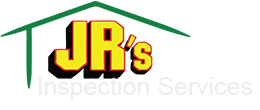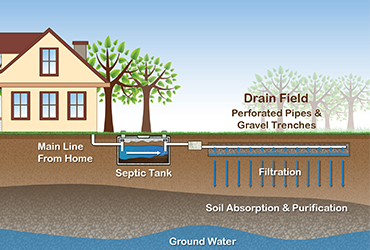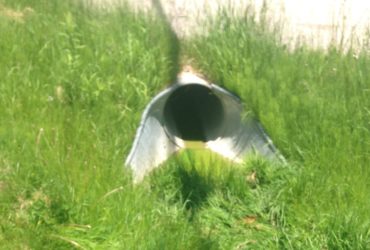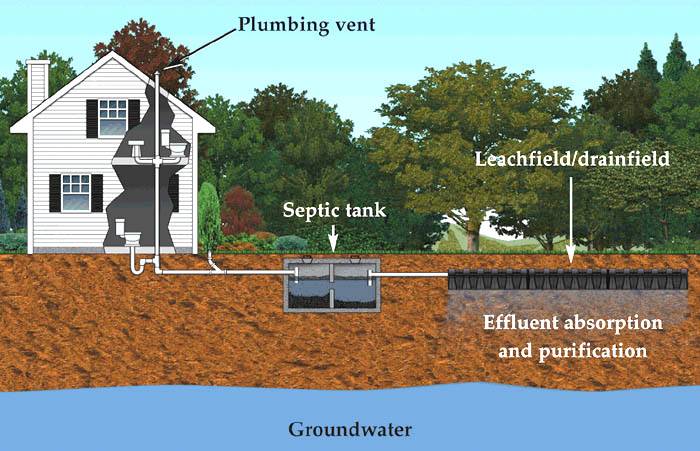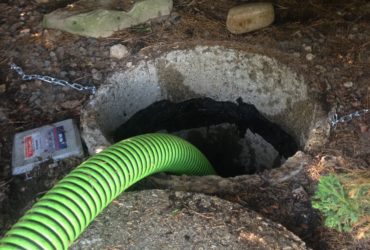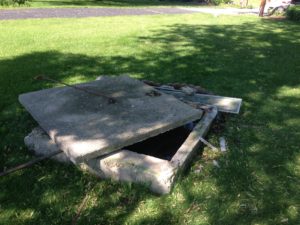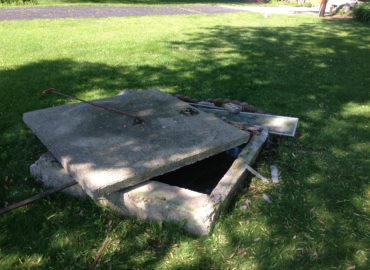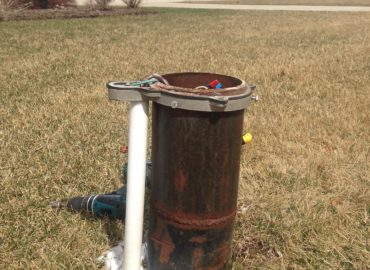Information, Operation & Management Of Septic Systems
A septic system is really a Wastewater Recycling System that utilizes the natural soil to treat the wastewater before returning it to the groundwater basin. What happens when you flush the toilet? Where does the wastewater go? For those of you not connected to a municipal sewer, the solution lies in the septic tank. A septic tank is typically the first component of a septic system. A system can be as simple as a septic tank and drainfield or include any number of add-ons, such as an aeration tank, sand filter, pump/siphon chamber or sand mound.
No one should enter a septic or other treatment or holding tank for any reason without being in full compliance with OSHA standards for entering a confined space. The atmosphere within the septic or other treatment or holding tank may contain lethal gases such as methane, and rescue of a person from the interior of the tank may be difficult or impossible.
A septic tank looks like the illustration to the right. The size of the tank depends upon the number of bedrooms in the house, not the number of people or plumbing fixtures. The sizes range from 750 gallons on up and may be configured as one or two septic tanks. Having two septic tanks (or a two compartment septic tank) increases retention time of the waste water, which helps to further reduce the suspended solids that could flow into the drainfield.
The drainfield is the area where the liquid from the septic tank soaks into the ground. The soil and micro-organisms remove viruses, bacteria, and most other contaminants typically found in household wastewater. The drainfield area may consist of one or more trenches, a rectangular bed or an above grade design like a mound (as discussed later). One or more observation tubes are placed in the drainfield area to monitor the infiltrative surface.
When the effluent (the technical name for the treated liquid from the septic tank) has to be lifted uphill into a drainfield, another tank is installed after the septic tank. This tank contains a pump with floating on and off switches to send the effluent into the drainfield at preset intervals. This pump tank (also known as a pump chamber, dosing chamber, or lift station) has a high water alarm float switch connected to an alarm to warn the user when the pump has failed to come on. Since 1980, pump tanks have about a one to three day’s reserve capacity once the pump fails and the alarm sounds. However, most septic system effluent pumps provide maintenance free service for many years.
The waste water entering the septic tank separates into 3 layers: 1. Solid waste that settles to the bottom of the tank; (sludge). 2. Grease, fat and floating solid materials which rise to the top of the tank; (scum). 3. A partially clarified liquid zone; (effluent).
The solid waste is food for anaerobic bacteria, which releases gas and liquid components. The gas is dispersed through the plumbing system vents in the house and drainfield vents. Solids do accumulate in the septic tank. The tank must be serviced (pumped out) every 3 years for non-pressurized systems or 2 years for pressurized systems like mounds, or whenever the solid component of the tank exceeds 1/3 of the tank volume to reduce the chance of solid material flowing into the drainfield.
Grease and other floating solids are prevented from flowing out of the tank by a baffle, filter, or screen located on the inside of the tank at the outlet end. Another baffle is placed on the inlet side of the septic tank. This forces the incoming waste down into the tank, which prevents short-circuiting across the tank. These baffles can deteriorate over time and must be checked at each tank servicing. In theory, only liquid flows out of the septic tank and into the drainfield, thereby recycling the household waste water into the ground. There are tank effluent filters available that can prevent larger suspended solids in wastewater from getting out of the septic tank, which may clog pumps, distribution pipes and soil. These filters are commonly serviced with routine septic tank pumping.
Effluent Filter/Screen
If your system is equipped with an effluent filter, it should be cleaned regularly to ensure proper operation. The filter cartridge must not be removed if the level in the tank is above normal, unless provisions are made to retain solids in the tank when it is removed from its enclosure. Typically, if the filter is clogged, and the level in the tank is above normal, you should call a septic pumper to pump the tank to a safe level below the filter. Removing a clogged filter if the tank level is above normal can allow sludge to leave the tank when the filter is pulled. This can cause damage to the septic drainfield. If the filter is equipped with an alarm, the filter shall be serviced if/when the alarm is activated continuously. Occasional short duration filter alarms may indicate surge flows or an impending continuous alarm.
Soil Infiltration System
The drainfield (soil infiltration) is the final and most important step of the effluent treatment and dispersal. The size, elevation, location and shape of the drainfield are all relative to the expected usage and soil characteristics.
The drainfield sizing is determined by the flow from the house (based on number of bedrooms) and the type of soil. Usually the more pervious the soil, the smaller the drainfield, however, a certified soil tester makes this determination based on the many physical features within the soil, such as texture, structure, consistence and layering of the soil. This information is recorded on a “Soil and Site Evaluation Report” form.
The elevation and location of the drainfield is determined by the soil characteristics and depth of limiting conditions such as seasonal water table, saturation zones within the soil, or bedrock. For systems without pretreatment, it is necessary to maintain a safe vertical distance of 3 feet between the bottom of the drainfield and limiting conditions for proper treatment and renovation of the effluent.
The shape of the drainfield is dependant upon the maximum length of suitable soil available, preferably along the contour. A drainfield design using trenches or narrow beds has been shown to improve aeration in the soil beneath the gravel thereby enhancing system treatment performance and longevity. When there are several trenches or beds, a distribution box may be incorporated to promote equal distribution of effluent.
Effluent inside the drainfield is dispersed in two ways – gravity or pressure distribution. Pressure distribution uses small diameter pipes and relies on a pump to force the effluent into the piping network. Research has shown that a pressure distribution network will effectively disperse the effluent throughout the drainfield evenly thereby delaying the over saturation of any one part of the drainfield. Saturation promotes clogging of the infiltrative surface.
There are circumstances that shorten the life of a drainfield:
1. Hydraulic Overloading. This is a condition where the soil beneath the drainfield becomes saturated resulting in ponding. This condition can be caused by:
(a) drainfield is undersized for the current usage
(b) leaking plumbing fixtures
(c) surface water into the system
(d) surge loading (e.g. doing all the clothes washing on one day)
2. Grease
Excessive grease can congeal in the sewer line to the septic tank or inside the tank. The septic tank may accumulate a layer of solid fat, which cannot be readily broken down by bacterial action. Grease should be treated as garbage and kept out of the septic tank whenever possible.
3. Sanitary napkins, condoms, cotton swabs, dental floss, tampons, handwipes, infant wipes, disposable diapers, and cigarette filters. These products are made of cellulose, plastic or other non-biodegradable components. They may plug the sewer lines, baffles and drainfield perforations or lodge in the pump.
4. Antibiotics, other medicines, disinfectants, painting products, gasoline, oil, degreasers and pesticides. When disposed of through the septic system, these chemicals may kill septic tank bacteria. This can result in a severe decline in decomposition of the septic tank solids. It can take several weeks for the bacteria in the septic tank to re-establish.
5. Clear water discharges. Building foundation drains, de-humidifier, and water softener discharges are considered clear water, which may be disposed into the ground separate from the septic system. Building foundation drains must never be connected to a septic system.
6. Surface drainage. Roof downspouts, driveway runoff and road ditches should be directed away from the septic system. The finished grade over the septic system should divert surface drainage of water away from the tanks and drainfield.
Septic System Questions & Answers
Q Should I add anything to my septic tank?
A Biological and chemical additives are not needed to aid or accelerate decomposition. At this time, there is no conclusive data to support the effectiveness of enzymes or any chemical treatment to rejuvenate a failing drainfield. These products are approved by the State of Wisconsin only if they do not harm the septic system.
Q What are the warning signs of a failing septic system?
A These signs may be indicators that the drainfield is failing:
1. Plumbing backups
2. Grass in the yard growing faster and greener in the area of the drainfield
3. Soft or mushy ground in the area of the drainfield
4. Sluggish toilet flushing
5. Septic pump runs constantly
6. Sludge accumulating in the drainfield vent or observation tubes
Q Can garbage disposals be used with a septic system?
A Yes, but try to avoid allowing grease or slowly biodegradable products such as coarse fruit, vegetable peelings and bones to get into the disposal.
Q Can I plant trees or shrubs over my drainfield?
A Generally no. Many tree species have roots that will attempt to grow into the drainfield to seek out moisture and nutrients. These may break sewer lines or disrupt the distribution of effluent. There are some trees and shrubbery whose root systems cannot stand “wet feet” and are safe to plant over or near drainfields. Your local landscape contractor or garden center is a good source of information.
Q What if liquid is observed in the drainfield vent or observation tubes?
A Liquid observed in the drainfield vent usually indicates that the soil absorption capability of the drainfield is reduced and ponding is progressing. Many systems begin ponding within the first few years. The ponded state of a drainfield is usually a slowly developing condition. The estimated life of today’s drainfields under normal usage is 15 to 25 years and sometimes much more. The performance and life expectancy of a septic system must never be judged by age alone. The drainfield can be ponded to some degree for many years and still function normally. A consistently rising level of ponding is a possible indicator as to the life expectancy of a drainfield. Sludge in a vent pipe or observation tube is an indicator of a more serious condition. Many lending institutions and some inexperienced inspectors have been using the observance of any liquid in a vent or observation tube as the sole criteria for failing a septic system for a proposed sale or purchase of a home. As noted above, this is an inaccurate conclusion. Technical failure of a septic drainfield is when the effluent is bleeding out onto the ground surface, wastewater backing up into the building (not due to plugged or broken sewer lines) or the existing drainfield was installed less than 3 feet to a saturation zone, groundwater, bedrock or impervious soil. Careful and accurate dye testing of the system by an experienced septic inspector is the only way to accurately access the remaining life expectancy of the drainfield.
Q Can I use my old drainfield later once a new one is installed?
A In most cases, yes. If the old drainfield was sized appropriately to its current use and there is at least 3 feet of suitable soil as described earlier, then the owner will be able to switch between the two drainfields by means of a diverter valve. It has been estimated that within a few years, an old ponded drainfield can recover much of its infiltrative capacity. For homes constructed after 1977 and having a below grade drainfield, a future replacement area will have already been designated. Once a replacement drainfield is installed the original drainfield will be allowed to rest and rejuvenate. Switching may occur every 1 to 5 years.
Q What can I do to prolong the life of my drainfield?
A There are a variety of things you can do: Install water saving devices and be on-guard for leaky fixtures. Water conservation reduces the amount of liquid going into the drainfield. Have the tank(s) pumped and inspected regularly. Keep surface water away from the septic system area, including the septic and pump tanks. Keep driveways, parked vehicles and buildings off the drainfield area. Soil compaction can cause premature failure by restricting the infiltrative and evaporative capability of the soil. Do not plant trees or large bushes over the septic system, the roots can clog and even break pipes. Installing an effluent filter to confine most of the suspended solids to the septic tank. The use of pretreatment components have been shown to improve effluent quality and moderate or reduce ponding. Understand what can and cannot be put into the septic tank.
[wpforms id=”1638″ title=”true” description=”true”]
